Small overlap front: driver-side
Rating applies to 2013-18 models
Tested vehicle: 2014 Ford C-Max Hybrid SE wagon
The Ford C-Max was introduced in the 2013 model year. The C-Max is a hybrid with both a gasoline engine and electric motor. These ratings apply only to C-Max Hybrid models and not C-Max Energi models (the latter can be charged by connecting the vehicle with an electrical cord to a household outlet).
| Evaluation criteria | Rating |
|---|---|
| Structure and safety cage | |
| Driver injury measures | |
| Head/neck | |
| Chest | |
| Hip/thigh | |
| Lower leg/foot | |
|
Driver restraints and dummy kinematics
The dummy’s head barely contacted the frontal airbag before sliding off the left side, leaving the head vulnerable to contact with forward side structure. The side curtain airbag deployed but does not have sufficient forward coverage to protect the head from contact with forward side structure and outside objects. | |
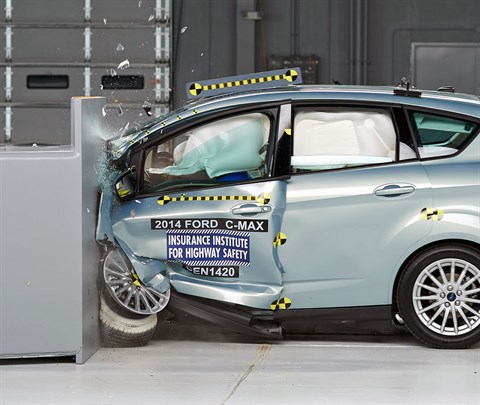
Action shot taken during the small overlap frontal crash test.
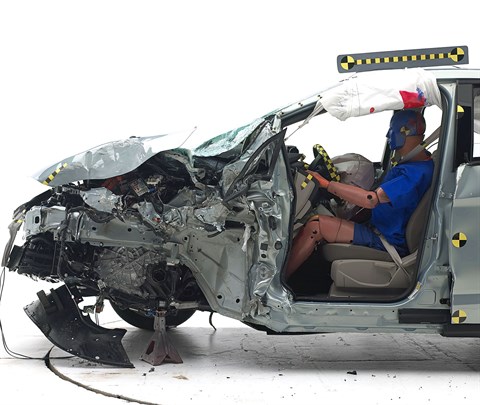
The dummy's position in relation to the door frame, steering wheel, and instrument panel after the crash test indicates that the driver's survival space was not maintained well.

During the crash, the dummy's head and torso barely contacted the airbag before sliding off to the left. The side curtain airbag did not extend far enough forward toward the A-pillar to protect the head from contact with forward side structure.
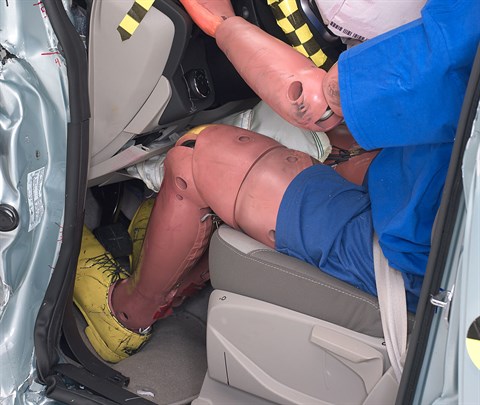
Despite considerable intrusion of the instrument panel, risk of injuries to the dummy's legs was low.
Moderate overlap front: original test
Rating applies to 2013-18 models
Tested vehicle: 2014 Ford C-Max Hybrid SE wagon
The Ford C-Max was introduced in the 2013 model year. The C-Max is a hybrid with both a gasoline engine and electric motor. These ratings apply only to C-Max Hybrid models and not C-Max Energi models (the latter can be charged by connecting the vehicle with an electrical cord to a household outlet).
| Evaluation criteria | Rating |
|---|---|
| Overall evaluation | |
| Structure and safety cage | |
| Driver injury measures | |
| Head/neck | |
| Chest | |
| Leg/foot, left | |
| Leg/foot, right | |
| Driver restraints and dummy kinematics | |
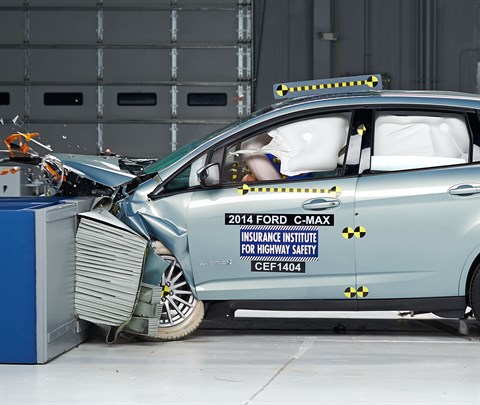
Action shot taken during the moderate overlap frontal crash test.
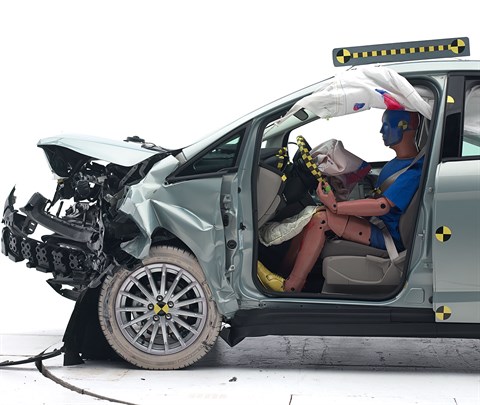
The dummy's position in relation to the steering wheel and instrument panel after the crash test indicates that the driver's survival space was maintained well.
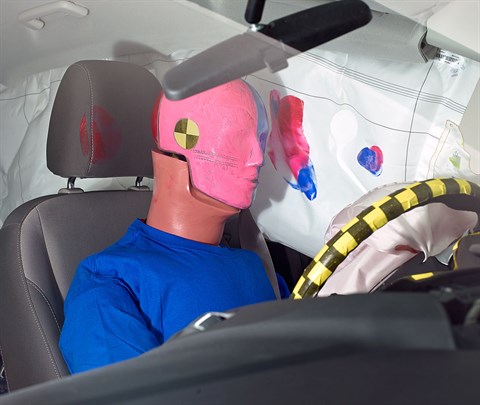
Smeared greasepaint shows where the driver dummy's head was protected from hitting hard structures during rebound by the side curtain airbag.
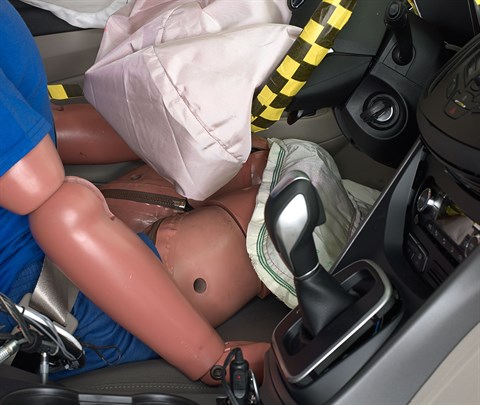
Forces on the lower right leg and foot were high enough to indicate the possibility of injuries.
Side: original test
Rating applies to 2013-18 models
Tested vehicle: 2014 Ford C-Max Hybrid SE wagon with standard front and rear head curtain airbags and standard front seat-mounted torso airbags
The Ford C-Max was introduced in the 2013 model year. The C-Max is a hybrid with both a gasoline engine and electric motor. These ratings apply only to C-Max Hybrid models and not C-Max Energi models (the latter can be charged by connecting the vehicle with an electrical cord to a household outlet).
| Evaluation criteria | Rating |
|---|---|
| Overall evaluation | |
| Structure and safety cage | |
| Driver injury measures | |
| Head/neck | |
| Torso | |
| Pelvis/leg | |
| Driver head protection | |
| Rear passenger injury measures | |
| Head/neck | |
| Torso | |
| Pelvis/leg | |
| Rear passenger head protection | |
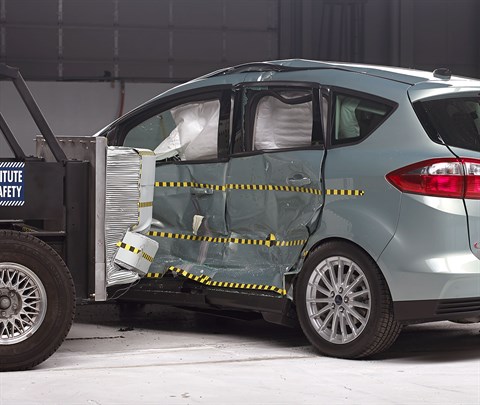
View of the vehicle and barrier just after the crash test.

View of the vehicle after the crash with doors removed, showing the side airbags and damage to the occupant compartment.
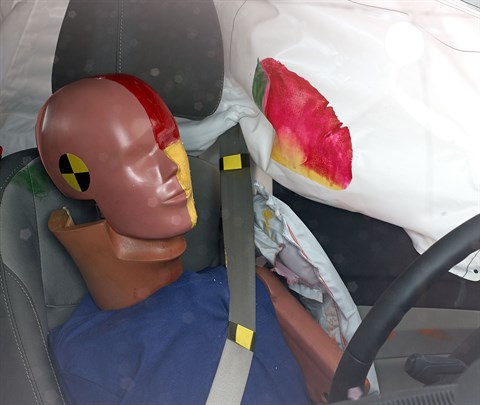
Smeared greasepaint shows where the driver dummy's head was protected from being hit by hard structures by the side airbags.
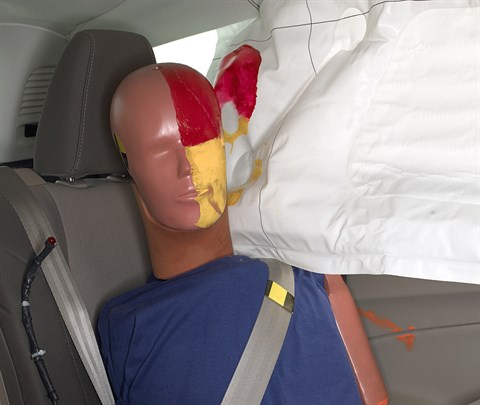
Smeared greasepaint shows where the rear passenger dummy’s head was protected by the side airbag.
Roof strength
Rating applies to 2013-18 models
Tested vehicle: 2014 Ford C-Max Hybrid SE wagon
| Overall evaluation | |
|---|---|
| Curb weight | 3,595 lbs |
| Peak force | 24,462 lbs |
| Strength-to-weight ratio | 6.80 |
Head restraints & seats
Seat type: Manual cloth seats
| Overall evaluation | |
|---|---|
| Dynamic rating | |
| Seat/head restraint geometry |
About the head restraint & seat test
Currently, IIHS tests apply only to front seats.
Child seat anchors
Rating applies to 2016-18 models
| Evaluation criteria | Rating |
|---|---|
| Overall evaluation | |
| Vehicle trim | SE |
| Seat type | cloth |
This vehicle has 2 rear seating positions with complete child seat attachment (LATCH) hardware.
It has 1 additional seating position with a tether anchor and the ability to borrow lower anchors from the other seating positions.
Note: When anchors are borrowed, they aren't available to use in their designated positions.
| Evaluation criteria | Rating |
|---|---|
| Overall evaluation | |
| Vehicle trim | SE |
| Seat type | cloth |
| Rating icon | Rating |
|---|---|
| G | Good |
| A | Acceptable |
| M | Marginal |
| P | Poor |
| Seating positions that rely on borrowed lower anchors or have only a tether anchor available are not rated. | |
thether anchor symbol | Tether anchor |
lower anchor symbol | Lower anchors |
| Lower anchor(s) can be borrowed from adjacent positions(s) | |
| No hardware available |
Details by seating position
| Position | Rating |
|---|---|
| 1 | |
| Tether anchor | |
| easy-to-find location | |
| no other hardware could be confused for anchor | |
| Lower anchors | |
| too deep in seat | |
| not too much force needed to attach | |
| difficult to maneuver around anchors | |
| 2 | |
| Tether anchor | |
| easy-to-find location | |
| no other hardware could be confused for anchor | |
| Lower anchors | |
| Can be borrowed from 1 and 3 | |
| 3 | |
| Tether anchor | |
| easy-to-find location | |
| no other hardware could be confused for anchor | |
| Lower anchors | |
| too deep in seat | |
| not too much force needed to attach | |
| easy to maneuver around anchors |
